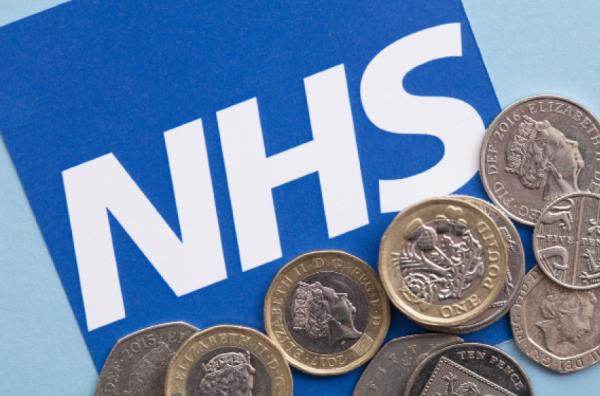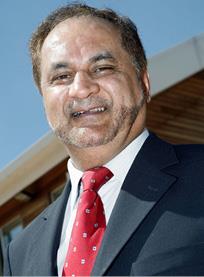09 December 2021

Chancellor Rishi Sunak handed the NHS £2.3bn to improve its ageing technology and IT systems. The question is: where is the money needed most? Robert Shepherd asks the questions
If there’s one organisation synonymous with underfunding, long-waiting times and being overrun at the worst possible time, then you’d do well to name one more beleaguered – indeed, more important – than the National Health Service (NHS).

Matthew Margetts, Smarter
The second largest healthcare system in the world and the country’s largest employer, successive (mainly Conservative) governments have long stood accused of failing to adequately fund the department.
Press coverage became even less favourable over the past 18 months as the Covid-19 pandemic laid bare the problems facing NHS. For prime minister Boris Johnson and his cabinet, the optics weren’t good.
“Public bodies continue to be reliant on outdated legacy systems, emphasising a ‘keeping the lights on’ approach at the expense of modernisation initiatives and the increased benefits they can bring,” says Mike Kiersey, director, global technology, EMEA at Boomi, which specialises in integration platform as a service (iPaaS) and master data management. “A modernisation program needs to look at rationalisation too, the reason why organisations find themselves in this state is due to the layer upon layers of technology debt that accumulates over time through ‘projects’ that continually add on and not remove. The complexity of middleware, integration, legacy ESB etc. is crippling the pace of which organisations can move, coupled with the fact they all need to be patched and managed to mitigate security risks.”
Last month, the NHS was given hope that its prayers were being answered. Up stepped chancellor of the exchequer Rishi Sunak adorned by his red box at the autumn budget, where he ringfenced north of £5bn for the healthcare system - £2.3bn of which is a cash injection (pardon the pun) for improving IT systems and technology.
You could hear the collective sigh of relief as network managers at trusts across the country, began to spend the money in their heads.
“It is always good to hear about further investment in the NHS,” says Matthew Margetts, director at IoT firm Smarter Technologies: “At the same time, however, I would like to hear about how the money is deployed and what changes the health service is introducing to improve outcomes; in particular, I believe there is scope for further investment in technology to manage patient care right through to track and trace for equipment and other assets that roll around hospitals.”

Noel O’Kelly, Spirit Digital
Noel O’Kelly, clinical director at health technology vendor Spirit Digital, says that “as far back as 2017, the government’s digital strategy policy paper outlined plans to ‘build a stronger, fairer country that works for everyone’”.
He argues that within the context of the NHS, this means having the infrastructure, connectivity, access, skills and confidence – amongst both those providing services and those receiving them – to make healthcare more equitable. “Indeed, as NHS Digital states, patients who are more likely to be digitally excluded include those who are amongst the more vulnerable: older people; those in lower income groups; people with disabilities; and those whose first language is not English, amongst others,” O’Kelly adds. “These are barriers that may be challenging to overcome, but they are not insurmountable, as the events of the last year and a half have shown.”

Russell Tilsed, 8x8
Vijay Magon, managing director at CCube Solutions – a supplier of electronic document and records management software to the NHS says that while “new money for NHS IT is of course welcome, the spending should be highly- focused” and that the second Johnson administration should avoid a ‘top down’ approach where IT is foisted upon trusts.”
However, Magon argues that “just doesn’t work” as evidenced by the National Programme of IT debacle during the Tony Blair administration.
“New money should be targeted on obvious problem areas which could provide quick and easy wins for the NHS to boost efficiency, improve patient safety and save money in the long run,” Magon says. “Take patient records - 12 years after St Helens & Knowsley Teaching Hospitals NHS Trust removed paper records from operational practice, around 50% of UK Trusts have still to get rid of their medical records libraries – the running of which wastes millions every year.”

Simon Townsend, IGEL
Of course, it doesn’t take a genius to know that the past 20 months have put the NHS under more strain than it had ever experienced in its 73-year existence. If you’re not convinced, just try to book a face-to-face appointment with your GP to get an idea.
That’s because pandemic also led to the transitioning of healthcare to the virtual clinic becoming crucial in fighting the pandemic and reducing the strain on the NHS.
Peter Ruffley, CEO, at big data and edge analytics Zizo, tells how IoT has enabled important new advances in remote monitoring through connected devices that can provide healthcare professionals with the ability to monitor on-going patient health and vitals from home.
“In rural and remote areas medical care has been known to fall behind standards elsewhere across the country, but technology can change this,” he says. “Technology and healthcare applications can be used to provide healthcare workers with access to interact with and monitor people in places that have been traditionally harder to reach – and crucially Edge Computing can be used to increase performance and responsiveness for this digitisation.
Cylera, a healthcare IoT (HIoT) cybersecurity and threat intelligence company, along with partner The AbedGraham Group, a physician-led global technology group, were recently commissioned by Dartford and Gravesham (DGT) NHS Trust to safeguard its medical device and IoT infrastructure.
“All NHS hospitals are in a similar situation with the need to accelerate towards the goal of decreasing IoT cyber risk,” says Shaun van Niekerk, head of IT and cybersecurity and joint chair of NHS Cyber Associates Network. “This unique compilation of technology provides the exceptional capabilities needed to reach this goal.”
O’Kelly says Covid-19 has been a catalyst for extraordinary change: but change has, so far, understandably been targeted at the most obviously vulnerable patients. “To achieve true digital inclusion, there is still an infrastructure to be built,” he says. “The priority is to address the technology gaps revealed by the Covid-19 NHS response and to use that knowledge to achieve a wider adoption of a broad, effective community care model within local health economies.”
Nevertheless, it appears there are a number of examples showing how the NHS has been running more economically.
IGEL is a company that provides the next-gen edge OS for cloud workspaces. Simon Townsend, its chief marketing officer, explains: “The NHS has apparently saved around two million hours using Microsoft Teams during the various lock downs as clinicians have been able to engage more effectively with colleagues and patients remotely even with all disruption caused by Covid. It is an excellent example of how IT has made a tangible difference. And just think what could be done with the extra £2bn if channeled effectively.”
Townsend says “putting apps, data and storage in the cloud” is how a modern health service should operate to enable telemedicine and improve patient care. “The cloud as an agile architectural approach has matured sufficiently such that security and performance is top class, roll out is fast, management easier with high availability guaranteed,” he adds.
As far as Kiersey, is concerned, the server landscape is still growing, as most customers have a multi-cloud strategy in place – however, on-premises still outweigh cloud.
“The wave that is gaining momentum is all about containers, moving monolithic applications, developing net new apps in a container world will outstrip that of ‘virtual machines’, he says. “I would say as ever IT services, application, databases needs to run on something and we are not seeing any slow down on the growth of applications and data. Most enterprise customers will have several overlapping applications to help them manage vast silos of data, compounded with the exponential growth of data, the variety of data, the ever demanding need to have real-time data access and the push from vendors to adopt their technologies is overwhelming for most IT organisations.”
Many trusts have now successfully made the migration, paving the way for others to do likewise. However, Magon argues that over the past 10 years, in excess of £35 million has been saved by three of CCube customers alone through the removal of paper-based processes and libraries. With the acceptance of cloud and subscription payment models, rollout is faster, less complex and easier for time pressed IT departments,” Magon continues. “The time is right to finally grapple with this for the 100+ trusts who have yet to do it.”
Russell Tilsed, senior director, public sector at integrated cloud communications platform provider 8x8, explains how his company “has the privilege of working with numerous NHS Trusts throughout the UK and so this recent decision by Chancellor Rishi Sunak to invest more fully within this market is a confirmation of our customers’ ongoing efforts to invest in digital transformation”. From handling patient inquiries and COVID-19 helplines to conducting virtual surgical training and participating in patient consultations via video, our customers are actively exploring all that’s possible when a traditionally in-person industry adopts cloud-based, collaborative technology. At 8x8, we work alongside our customers to ensure that as they grow, we grow right alongside them to meet any changes in their business needs. As the NHS and technology vendors continue working together, actively communicating requirements and needs will be imperative to meeting the current and future needs of each organisation and its patients.”
As we look to a (hopefully) brighter future for the NHS, O’Kelly believes that “with the right pathway in place, the opportunity presents itself to move from the current model of reactive care, to one where we can start to intervene early and prevent unnecessary exacerbations or avoidable hospital admissions”.
He continues: “With a patient-centric, digital-first approach, the wider health economy will gain from a huge influx of data. Data that can be analysed, using machine learning and artificial intelligence, to help us predict the people who are more at risk, from either physical or psycho-social conditions. Ultimately, it’s about improving pathways, outcomes, access to medicines and reducing the cost of healthcare. The key to digital inclusion is getting the right local stakeholders within a local health economy to work together. It is the cooperation of policymakers, front line clinicians and IT suppliers within a local area that will accelerate digital change and achieve a model of care designed to be truly inclusive.”
Margett adds: “Moreover, clearly the NHS must report on the measures it is taking to cut carbon emissions and reduce environmental impact. Again, it would be interesting to understand what initiatives they are pursuing.”

Vijay Magon, CCube Solutions
Still, there are those who are of the view that the NHS needs to be prudent about where to splash the cash and Townsend says “being laser focused” about this £2 billion opportunity is fundamentally important. “The extra money shouldn’t be seen as a bonanza for IT suppliers or NHS IT departments to just buy the latest and greatest tech,” he warns. “Projects need to have clear business case returns. For example, NHS trusts that have already made the shift to virtual desktop infrastructure - whether this is in the cloud or still on-premise – are already seeing the benefits from hosting Windows-based desktops and apps somewhere other than actually on the endpoint.”
This approach, which enables work from anywhere, is significantly more secure and easier for IT to manage, argues Townsend. He adds that in this model, where Windows no longer sits on every PC, organisations can also utilise technologies like that from IGEL. “Pennine Acute Hospitals NHS Trust is a great example of this,” he continues. “They saved £500,000 as they avoided buying 2,000 new thin client devices for the organisation, with just one person managing the whole estate. To repeat, NHS Trusts don’t need to throw old PCs, laptops or thin clients away which saves a lot of money and meets the green agenda, too. The point is to work smart to use the government’s new budget and apply it across the whole IT stack.”
For Ruffley, “connected devices are the future” and will leverage intuitive data analysis that ultimately saves lives and streamlines operational efficiency for health services across the nation. “By reducing the myths surrounding patient data and ensuring that connected devices are managed as part of one centralised system, healthcare providers can gain endless value and benefits from IoT,” he says.
Kiersey says “in the new world, there is no end state, there is no need for overengineered solutions which run touched for three years”. He concludes: “CTOs need to innovate with flexibility, decouple apps and data with APIs to enable the adoption of new technologies like AI.”
Naturally, each trust and/or hospital will have their own views on where the money can and should be spent, but the good news is two-fold: the money is available and there are vendors ready to help.
Oh, for those of you who didn’t Google “world’s largest healthcare system”, it’s Brazil’s Sistema Único de Saúde (SUS). That’s one for your Christmas quiz.
-(002).png?lu=245)







